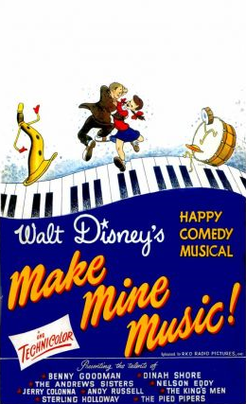| Make Mine Music | |
|---|---|
 Theatrical release poster | |
| Directed by |
|
| Story by |
|
| Based on | "Casey at the Bat" by Ernest Thayer Peter and the Wolf by Sergei Prokofiev |
| Produced by | Walt Disney Joe Grant |
| Starring | |
| Music by | |
Production company | |
| Distributed by | RKO Radio Pictures |
Release dates | |
Running time | 75 minutes |
| Country | United States |
| Language | English |
| Budget | $1.35 million [2] |
| Box office | $3.275 million (worldwide rentals) [3] |
Make Mine Music is a 1946 American animated musical anthology film produced by Walt Disney and released by RKO Radio Pictures on April 20, 1946.
Contents
- Film segments
- The Martins and the Coys
- Blue Bayou
- All the Cats Join In
- Without You
- Casey at the Bat
- Two Silhouettes
- Peter and the Wolf
- After You've Gone
- Johnnie Fedora and Alice Bluebonnet
- Finale: The Whale Who Wanted to Sing at the Met
- Cast
- Music
- Release
- Home media
- Reception
- Box office
- Critical response
- See also
- Notes
- References
- External links
During World War II, much of Walt Disney's staff was drafted into the army, and those that remained were called upon by the U.S. government to make training and propaganda films. As a result, the studio was littered with unfinished story ideas. In order to keep the feature film division alive during this difficult time, the studio released six package films including this one, made up of various unrelated segments set to music. This is the third package film, following Saludos Amigos and The Three Caballeros . The film was entered into the 1946 Cannes Film Festival. [4]